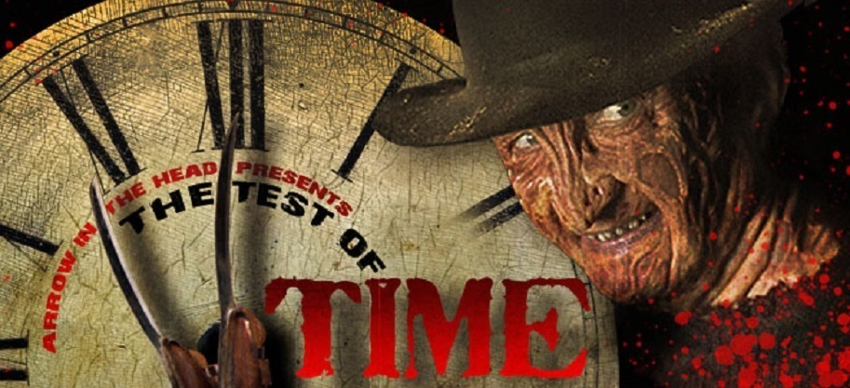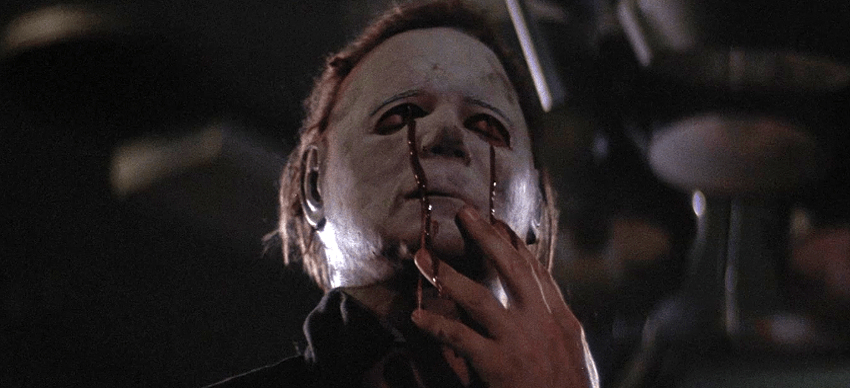

We all have certain movies we love. Movies we respect without question because of either tradition, childhood love, or because they’ve always been classics. However, as time keeps ticking, do those classics still hold up? Do they remain must-see? So…the point of this column is to determine how a film holds up for a modern horror audience, to see if it stands the Test of Time.


DIRECTED BY RICK ROSENTHAL
STARRING JAMIE LEE CURTIS, DONALD PLEASANCE, DICK WARLOCK, LEO ROSSI, TAWNY MOYER
Trick or Treat motherf*ckers! From all of us here at Arrow in the Head…here’s wishing ya’ll a happy, harrowing, and horrifying Halloween!
Speaking of All Hallow’s Eve, don’t look now, but just as Halloween Kills continues to stalk and slash via streaming, John Carpenter, Debra Hill, and Rick Rosenthal’s Halloween II (WATCH IT HERE / OWN IT HERE) turned 40 years old this year. That’s right y’all, what’s considered as one of the finer sequels in one of the longest-running horror franchises of all time is now officially a middle-aged bald man stuck on the couch with a floundering dad bod. The film was released three years after Carpenter’s indie trailblazing and trendsetting smash indie slasher hit Halloween and was largely deemed a critical and commercial misfire despite grossing roughly ten times its budget ($2.5 million to make versus $25 million grossed internationally). Panned as a hyper-violent knockoff meant to capitalize on its namesake and cash in on the concomitant craze of cheap and gory slasher movies ironically fostered by the original, Halloween II ended up being the final film in the franchise produced by Universal, and the final time the series would feature Jamie Lee Curtis and Donald Pleasance in the same film.
And yet, when compared to some of the subsequent entries in the film, Halloween II continues to rank among the more beloved Michael Myers holiday massacres. Saddle the f*ck up folks, we’re about to slice and dice up the tricks and treats of Halloween II when it faces the 40-year Test of Time below!
THE STORY: As it goes, John Carpenter was approached to direct a sequel to his landmark indie slasher mega-hit by Universal but felt, along with his co-writer Debra Hill, that the original Halloween was always conceived as a sequel. When the studio flashed too much money for Carpenter to deny, he agreed to pen a script and produce a sequel but did not want to return to the director’s chair. Instead, Carpenter chose Rick Rosenthal. While the original draft of the script set the story in a high-rise apartment complex but was eventually changed to a Haddonfield Memorial Hospital, immediately picking up from the events that ended Halloween. Laurie Strode (Curtis), fresh off a sadistic salvo of stalk-and-slash scarification, is taken to the local clinic to dress her wounds and keep her out of harm’s way. Alas, Michael Myers’ (Dick Warlock, who doubles as the policeman who runs down Ben Tramer) murderous motives are met with his evil ire and soon the relentless revenant ambles his way to the Haddonfield Hospital to deal as much deadly damage as possible. All the while, Dr. Loomis (Pleasance) feverishly races to quell the marauding onslaught of abject carnage and keep Laurie safe. Cue all sorts of grisly mayhem and ultra-gruesome Halloweentime horror!
WHAT HOLDS-UP: For a sequel made three after such a watershed original, one of the first things that remains convincing about Halloween II is the organic continuation of the first film. By setting the film the following day (the only Halloween franchise entry to depict November 1st), Carpenter and Hill brilliantly lay a connective bridge to the original that immediately plunges viewers back into Laurie’s world. However, it’s one thing to write a sequel in hopes of it feeling like a germane continuation of the original story, but executing is another altogether. Halloween retains its intrinsic link to the original in a way that feels authentic and unforced, something the later franchise entries sorely lacked (despite being fun in their own right). But beyond the ability to craft a sequel that feels honest and tonally reflective of the original, the horrifying hospital setting is another aspect of the movie that continues to be a strength in 2021.
While some have criticized the hospital setting for being too bare, lifeless, and understaffed to be credible, according to an experience Rick Rosenthal really had with his wife in California, this was the exact point of placing the story inside a clinic during a typical graveyard shift. Hospitals are places meant to foster health, keep people safe, preserve life, and prevent death. By allowing Michael to stalk and slash his way through such an otherwise trustworthy institution of healing and well-being is downright brilliant, as it completely subverts the preconceived notions viewers have in such a safe place, and turns a bastion of life-keeping into a frightening catafalque flooded with brutal bloodshed. We expect Laurie to be nursed back to health and remain physically guarded, but these expectations are flipped on their head. The hospital setting in Halloween II remains one of the movie’s strongest aspects, turning a societal safe haven into a dark, silent cemetery sealed with sinister seclusion. There’s a reason why Rob Zombie returned to the setting in his version of Halloween 2, as it’s one of the smartest ad scariest places to set a horror story.
Although the original Halloween is a sterling example of less-is-more horror filmmaking that relies on well-staged framing, camera work, well-mounted tension and suspense, and that bone-clattering musical score, the sequel delivers what good horror extensions promise – bigger, better, more grisly onscreen carnage. Halloween II certainly delivers in this regard thanks to three nights of reshoots done by Carpenter himself after he deemed Rosenthal’s initial cut too tame. From the onset, the idea from both men was to retain the atmospheric, less-is-more approach, but with the gore-sodden slasher movie craze of 1980-1981, Universal pressured Carpenter to increase the grisly violence in the film, much to the dismay of Rosenthal. As such, some of the most inventive and durably memorable fatalities in the film came from Carpenter’s directorial reshoots. Let us count thee flays…
Halloween II features some of the most ferociously frightening assortment of death modes and menacing murder weapons that never over-relies on Michael’s trusty butcher knife. In fact, Michael only murders one person (the first victim) with his butcher blade and wickedly waylays the rest of his victims through creative ways that are also germane to the hospital setting.
After flaying a female teen with the stolen kitchen knife, Myers overhears a news brief on a kid’s boombox and heads toward Haddonfield Memorial to kill Laurie once and for all. The first bit of business Michael conducts inside is an awesome double homicide of Budd, whom Michael strangles in a really cool out-of-focus background shot as his girlfriend Karen cranks up the dial on the hot tub in the foreground. With expertly mounting tension and suspense, use of sound and silence, light and shadow, Michael then repeatedly plunges the sexy ass broad’s head plum into the boiling vat of water (which was freezing in real life) until nasty puss-ridden boils festoon her face and flesh falls off the bone like a goddamn rotisserie chicken.
Next up, Michael murders the drunk chief surgeon cruelly cramming a hypodermic needle in his eyeball, the contents of which are never divulged. Moments later, appearing from the shadows behind Nurse Janet in a freaky image, Myers quickly jabs the same needle into her temple and plunges air into her cranium to kill her via an instant aneurysm. Even more elaborate, Michael is later revealed to have slaughtered Nurse Alves and drained her blood through a medical tube that Jimmy later slips and falls into in yet another memorably morbid mini-massacre. These deaths are not only wildly inventive in the context of the Halloween franchise but also incorporate the hospital setting in ways that subvert the place of safety by turning it into a haunted charnel house of pure pain.
Untainted by senescent CGI or cheap VFX, one of Michael’s most lasting murders comes when he appears in the hallway behind Nurse Jill, violently jams a scalpel in her back, lifts her three feet in the air, and unceremoniously drops her with a thud in front of a terrified Laurie. Sick, simple, and still severely unsettling!
WHAT BLOWS NOW: For iconic as Laurie Strode has become as a generational scream queen, her brief 25-minute screentime in Halloween II leaves a lot to be desired. That said, in her limited appearance, I’d argue Jamie Lee Curtis gives a better and more physically taxing performance than she did in the original, which happened to be her film debut. By making The Fog, Prom Night, Terror Train, and the highly underrated Road Games in rapid succession in 1980-81, she quickie found a performative horror movie groove that, even though the story is set the following night, is more nuanced and mature in Halloween II. The movie would no doubt benefit if Curtis was on screen more often, but as disappointing as her glaring absence is for long stretches, the trade-off of quality for quantity sort of makes the overall result a zero-sum situation.
THE VERDICT: 40 years later, Halloween II remains one of the top two or three Halloween sequels ever made. The unique hospital setting, the increased onscreen carnage, the alarming array of inventive fatalities that are germane to the unique setting, and the seamless transition of a three-year sequel feeling like an organic continuation of the original Halloween are among the reasons why the movie continues to resonate as one of Michael Myer’s most banner, baleful, and brutal horror holidays on record. Happy Halloween boils and ghouls!